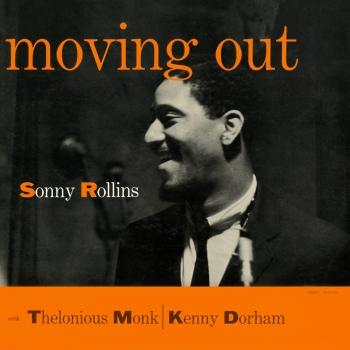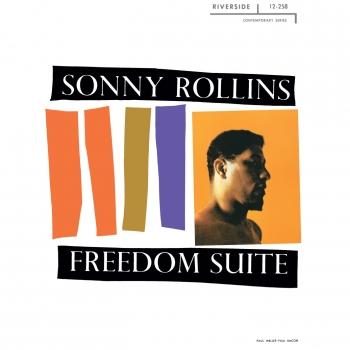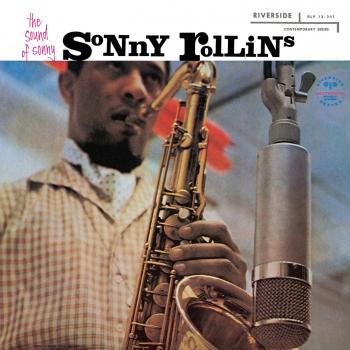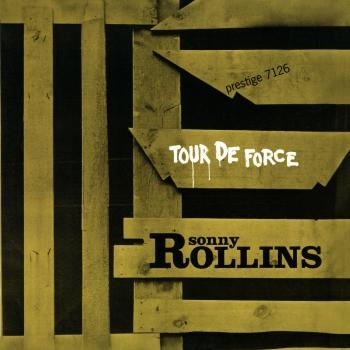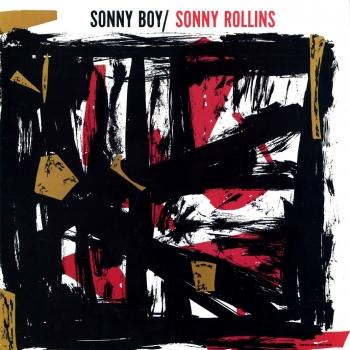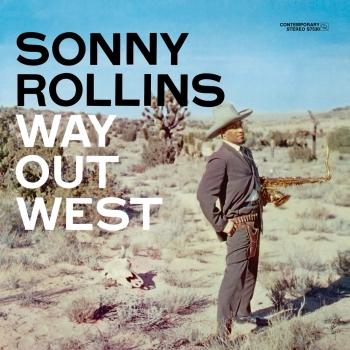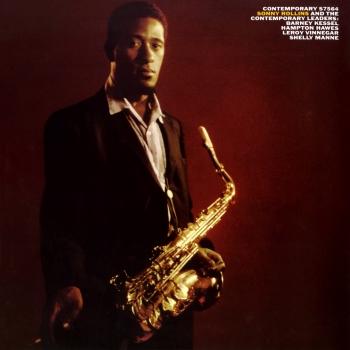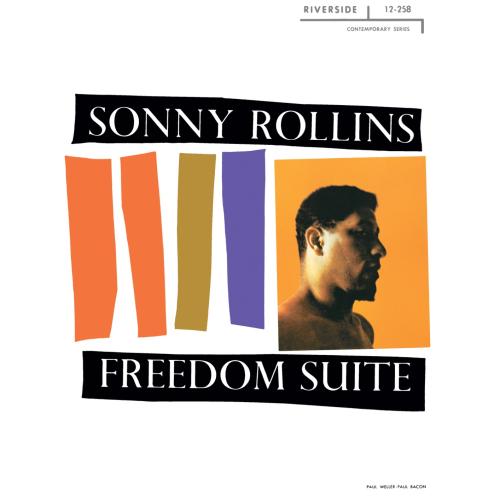
Freedom Suite (Remastered) Sonny Rollins
Album info
Album-Release:
1958
HRA-Release:
20.01.2017
Album including Album cover Booklet (PDF)
I`m sorry!
Dear HIGHRESAUDIO Visitor,
due to territorial constraints and also different releases dates in each country you currently can`t purchase this album. We are updating our release dates twice a week. So, please feel free to check from time-to-time, if the album is available for your country.
We suggest, that you bookmark the album and use our Short List function.
Thank you for your understanding and patience.
Yours sincerely, HIGHRESAUDIO
- 1 The Freedom Suite 19:22
- 2 Someday I'll Find You 04:40
- 3 Will You Still Be Mine? 02:59
- 4 Till There Was You (Take 4) 04:59
- 5 Shadow Waltz 04:12
Info for Freedom Suite (Remastered)
With 15 albums under his belt, Sonny Rollins was poised to make a bold statement with 1958's Freedom Suite. Sporting a Mohawk haircut on the inside cover, Rollins was driven by the political climate at the time, acknowledging and questioning his place in society as an African American in the midst of the Civil Rights Movement. In the nearly 20-minute long title track, comprised of five movements, Rollins and his longtime collaborators drummer Max Roach and bassist Oscar Pettiford were able to dig deep and explore the melodic structure. Side B is comprised of four Broadway showtunes and standards, which Rollins, Roach and Pettiford make their own. An inspired and vibrant boundary-pushing album.
„By February of 1958, when Sonny Rollins recorded Freedom Suite, his political consciousness had risen to match the poetic scope of his music. In addressing his place as a creative artist and an African-American, Rollins recognized that both aspects of his being existed under second-class circumstances, and that it was time for this country to review these inequities. In recording with bassist Oscar Pettiford and drummer Max Roach, Rollins aligned himself with the modern jazz innovators who best exemplified his righteous brand of freedom. Pettiford is particularly inspired on trio and duo versions of "Till There Was You," where he displays an uncanny knack for enunciating lyrical syncopations without losing the flow of the beat or a sense of harmonic structure. His ringing half notes on the head to "Will You Still Be Mine?" set up a vibrant series of Rollins/Roach exchanges, while his charming solo distills the melody into its most swinging components. But it's "Freedom Suite," with its stunning stops and starts, extended variations, thematic interludes, and exhilarating denouement, that invites the most superlatives. Rollins' sense of sustained melodic invention is remarkable, as is his cyclical formal structure. The opening theme, with its affectionate parody of a formal overture, sets the band in motion, as if motifs and contrasting themes criss-cross and collide in a swinging trialogue. A waltz figure and dramatic, extended cadenza introduces one of Rollins' most touching ballads, richly tinted in smoky shades of blue, with some joyous buck and wing by Pettiford and Roach. Finally, a reprise of the waltz theme gives way to a climactic chase, inspiring some of Roach's most fervent, singing breaks, before a return to the opening theme ties it all up.“ (Scott Yanow, AMG)
Sonny Rollins, tenor saxophone
Oscar Pettiford, bass
Max Roach, drums
Recorded February 1958 in New York, New York
Produced by Orrin Keepnews
Digitally remastered
Sonny Rollins
will go down in history as not only the single most enduring tenor saxophonist of the bebop and hard bop era, but also the greatest contemporary jazz saxophonist of them all. His fluid and harmonically innovative ideas, effortless manner, and easily identifiable and accessible sound have influenced generations of performers, but have also fueled the notion that mainstream jazz music can be widely enjoyed, recognized, and proliferated. Born Theodore Walter Rollins in New York City on September 7, 1930, he had an older brother who played violin. At age nine he took up piano lessons but discontinued them, took up the alto saxophone in high school, and switched to tenor after high school, doing local engagements. In 1948 he recorded with vocalist Babs Gonzales, then Bud Powell and Fats Navarro, and his first composition, "Audubon," was recorded by J.J. Johnson. Soon thereafter, Rollins made the rounds quickly with groups led by Art Blakey, Tadd Dameron, Chicago drummer Ike Day, and Miles Davis in 1951, followed by his own recordings with Kenny Drew, Kenny Dorham, and Thelonious Monk.
In 1956 Rollins made his biggest move, joining the famous ensemble of Max Roach and Clifford Brown, then formed his own legendary pianoless trio with bassist Wilbur Ware or Donald Bailey and drummer Elvin Jones or Pete La Roca in 1957, doing recorded sessions at the Village Vanguard. Awards came from Down Beat and Playboy magazines, and recordings were done mainly for the Prestige and Riverside labels, but also for Verve, Blue Note, Columbia, and Contemporary Records, all coinciding with the steadily rising star of Rollins. Pivotal albums such as Tenor Madness (with John Coltrane), Saxophone Colossus (with longstanding partner Tommy Flanagan), and Way Out West (with Ray Brown and Shelly Manne), and collaborations with the Modern Jazz Quartet, Clark Terry, and Sonny Clark firmly established Rollins as a bona fide superstar. He also acquired the nickname "Newk" for his facial resemblance to Brooklyn/Los Angeles Dodgers pitcher Don Newcombe.
But between 1959 and 1961 he sought a less superficial, more spiritual path to the rat race society of the times, visiting Japan and India, studying yoga and Zen. He left the music business until 1962, when he returned with the groundbreaking and in many ways revolutionary recording The Bridge with guitarist Jim Hall for the RCA Victor/Bluebird label. Rollins struck up a working relationship with trumpeter Don Cherry; did a handful of innovative LPs for the RCA Victor, MGM/Metro Jazz, and Impulse! labels; did one record with his hero Coleman Hawkins; and left the scene again in 1968. By 1971 he came back with a renewed sense of vigor and pride, and put out a string of successful records for the Milestone label that bridged the gap between the contemporary and fusion jazz of the time, the most memorable being his live date from the 1974 Montreux Jazz Festival, The Cutting Edge. Merging jazz with calypso, light funk, and post-bop, the career of Rollins not only was revived, but thrived from then onward. He was a member of the touring Milestone Jazz Stars in 1978 with McCoy Tyner and Ron Carter, and gained momentum as a touring headliner and festival showstopper.
His finest Milestone recordings of the second half of his career include Easy Living, Don't Stop the Carnival, G-Man, Old Flames, Plus Three, Global Warming, This Is What I Do, and Without a Song: The 9/11 Concert. He has worked extensively with road and recording bands that have included such artists as electric bass guitarist Bob Cranshaw; trombonist Clifton Anderson; pianists Tommy Flanagan and Stephen Scott; keyboardist Mark Soskin; guitarists Bobby Broom and Jerome Harris; percussionist Kimati Dinizulu; and drummers Jack DeJohnette, Perry Wilson, Steve Jordan, and Al Foster. Rollins formed his own record label, Doxy, through which he issued the CD Sonny, Please in 2006. Well into his eighth decade of life, Rollins continued to perform worldwide. As a composer, he will always be known for three memorable melodies that have become standards and well-recognized tunes in the jazz canon -- "Oleo," "Airegin," and especially "St. Thomas." (Michael G. Nastos). Source: Blue Note Records.
Booklet for Freedom Suite (Remastered)
















